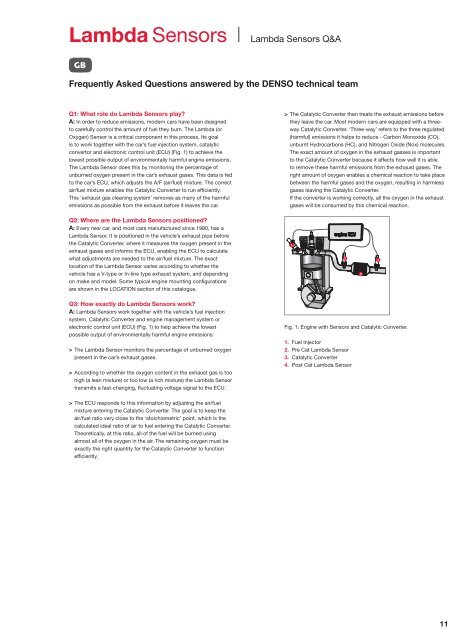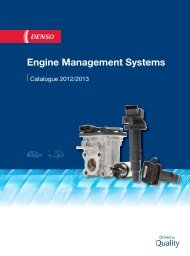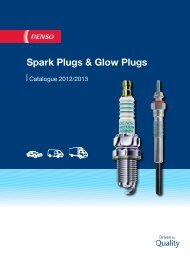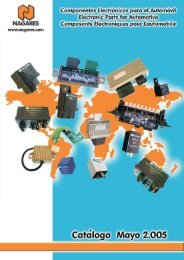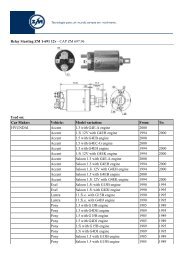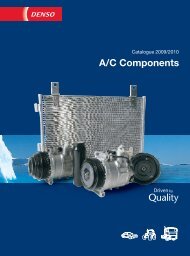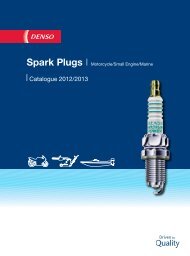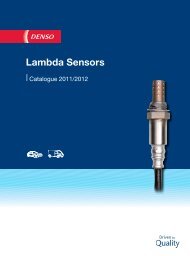Lambda Sensors |
Lambda Sensors |
Lambda Sensors |
You also want an ePaper? Increase the reach of your titles
YUMPU automatically turns print PDFs into web optimized ePapers that Google loves.
<strong>Lambda</strong> <strong>Sensors</strong> <strong>Lambda</strong> <strong>Sensors</strong> Q&A<br />
Frequently Asked Questions answered by the DENSO technical team<br />
Q1: What role do <strong>Lambda</strong> <strong>Sensors</strong> play?<br />
A: In order to reduce emissions, modern cars have been designed<br />
to carefully control the amount of fuel they burn. The <strong>Lambda</strong> (or<br />
Oxygen) Sensor is a critical component in this process, Its goal<br />
is to work together with the car’s fuel injection system, catalytic<br />
convertor and electronic control unit (ECU) (Fig. 1) to achieve the<br />
lowest possible output of environmentally harmful engine emissions.<br />
The <strong>Lambda</strong> Sensor does this by monitoring the percentage of<br />
unburned oxygen present in the car’s exhaust gases. This data is fed<br />
to the car’s ECU, which adjusts the A/F (air/fuel) mixture. The correct<br />
air/fuel mixture enables the Catalytic Converter to run efficiently.<br />
This ‘exhaust gas cleaning system’ removes as many of the harmful<br />
emissions as possible from the exhaust before it leaves the car.<br />
Q2: Where are the <strong>Lambda</strong> <strong>Sensors</strong> positioned?<br />
A: Every new car, and most cars manufactured since 1980, has a<br />
<strong>Lambda</strong> Sensor. It is positioned in the vehicle’s exhaust pipe before<br />
the Catalytic Converter, where it measures the oxygen present in the<br />
exhaust gases and informs the ECU, enabling the ECU to calculate<br />
what adjustments are needed to the air/fuel mixture. The exact<br />
location of the <strong>Lambda</strong> Sensor varies according to whether the<br />
vehicle has a V-type or In-line type exhaust system, and depending<br />
on make and model. Some typical engine mounting configurations<br />
are shown in the LOCATION section of this catalogue.<br />
Q : How exactly do <strong>Lambda</strong> <strong>Sensors</strong> work?<br />
A: <strong>Lambda</strong> <strong>Sensors</strong> work together with the vehicle’s fuel injection<br />
system, Catalytic Converter and engine management system or<br />
electronic control unit (ECU) (Fig. 1) to help achieve the lowest<br />
possible output of environmentally harmful engine emissions:<br />
> The <strong>Lambda</strong> Sensor monitors the percentage of unburned oxygen<br />
present in the car’s exhaust gases.<br />
> According to whether the oxygen content in the exhaust gas is too<br />
high (a lean mixture) or too low (a rich mixture) the <strong>Lambda</strong> Sensor<br />
transmits a fast-changing, fluctuating voltage signal to the ECU.<br />
> The ECU responds to this information by adjusting the air/fuel<br />
mixture entering the Catalytic Converter. The goal is to keep the<br />
air/fuel ratio very close to the ‘stoichiometric’ point, which is the<br />
calculated ideal ratio of air to fuel entering the Catalytic Converter.<br />
Theoretically, at this ratio, all of the fuel will be burned using<br />
almost all of the oxygen in the air. The remaining oxygen must be<br />
exactly the right quantity for the Catalytic Converter to function<br />
efficiently.<br />
> The Catalytic Converter then treats the exhaust emissions before<br />
they leave the car. Most modern cars are equipped with a threeway<br />
Catalytic Converter. ‘Three-way’ refers to the three regulated<br />
(harmful) emissions it helps to reduce - Carbon Monoxide (CO),<br />
unburnt Hydrocarbons (HC), and Nitrogen Oxide (Nox) molecules.<br />
The exact amount of oxygen in the exhaust gasses is important<br />
to the Catalytic Converter because it affects how well it is able<br />
to remove these harmful emissions from the exhaust gases. The<br />
right amount of oxygen enables a chemical reaction to take place<br />
between the harmful gases and the oxygen, resulting in harmless<br />
gases leaving the Catalytic Converter.<br />
If the converter is working correctly, all the oxygen in the exhaust<br />
gases will be consumed by this chemical reaction.<br />
1<br />
2<br />
Fig. 1: Engine with <strong>Sensors</strong> and Catalytic Converter.<br />
1. Fuel Injector<br />
2. Pre Cat <strong>Lambda</strong> Sensor<br />
. Catalytic Converter<br />
. Post Cat <strong>Lambda</strong> Sensor<br />
11


